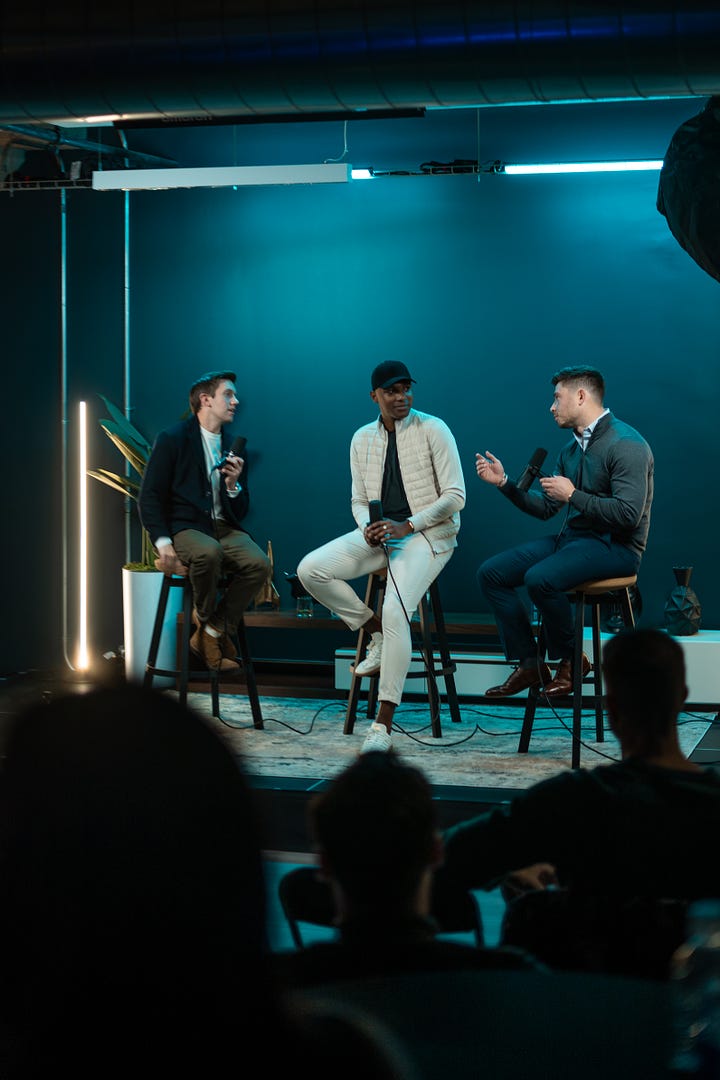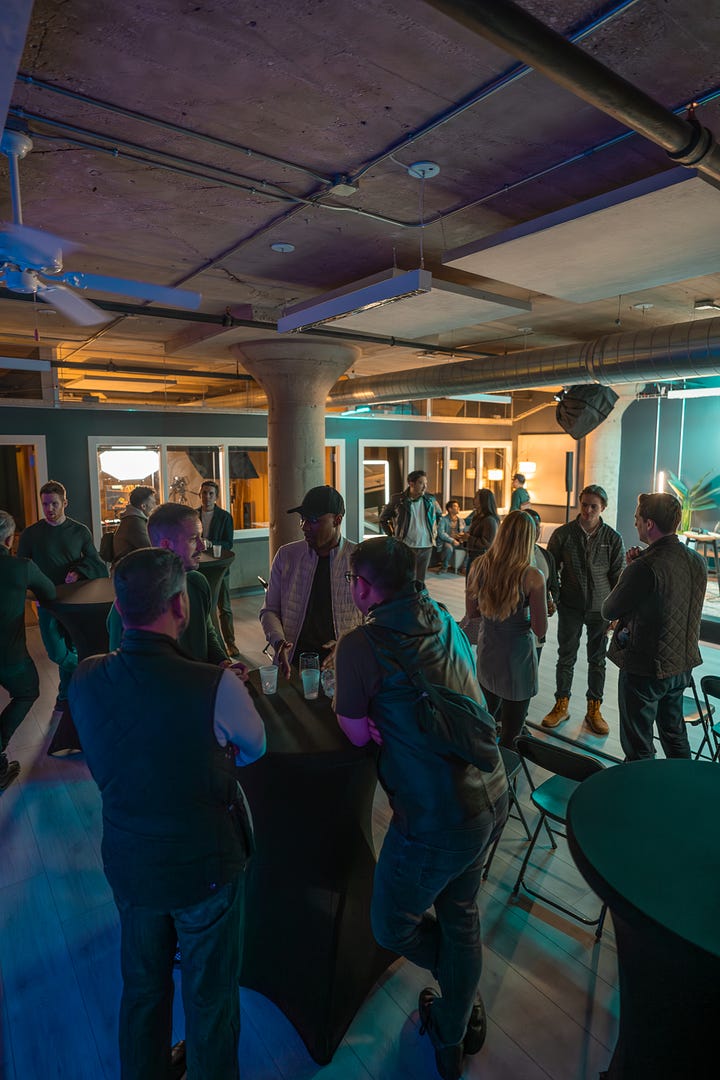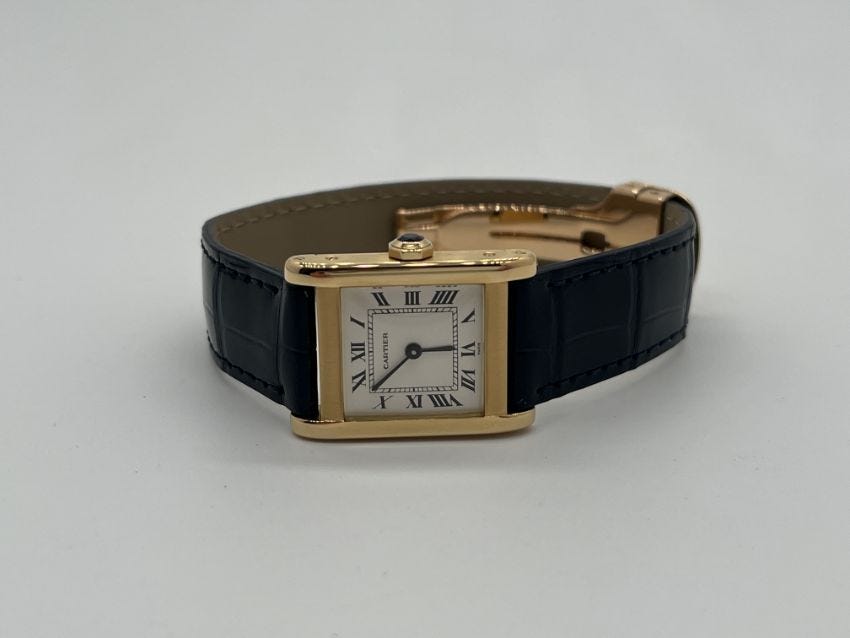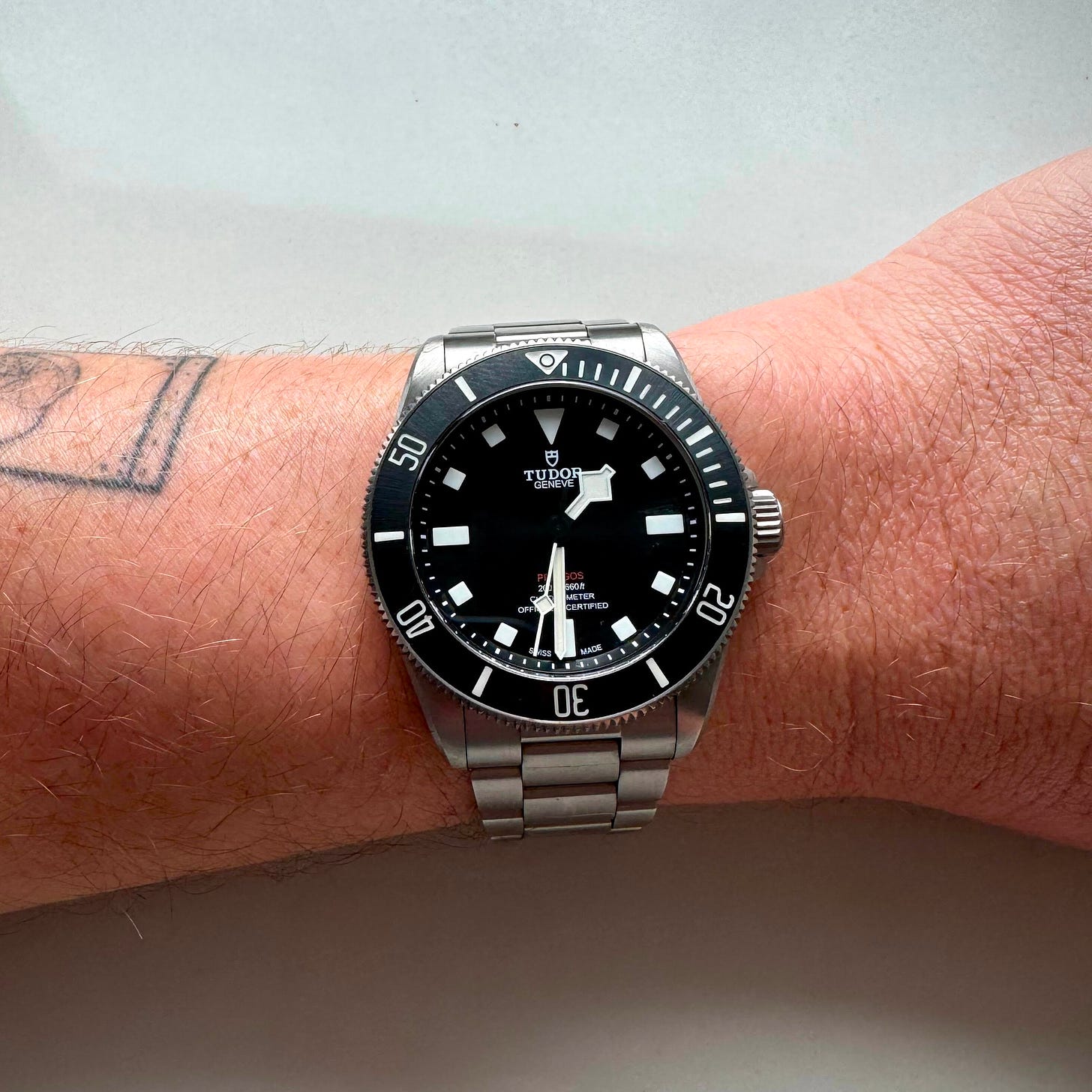You Can't Discount Timelessness
On good watches and Black Friday; vintage finds from Cartier to a Carrera; and GQ's watch brand of the year
I’ve got a couple of longer articles on (1) watchmaking school in the U.S. and (2) watch media, but I feel they’d be wasted on Black Friday. So today’s newsletter is more of a sit-back-and-relax in between football and online shopping.
In this letter: Black Friday, Cartier Tank Normale, Chopard L.U.C 1860, GQ, Heuer Carrera 2447, Tudor Pelagos 39, Worn & Wound, and more.
A warm welcome to all the new subscribers (more on that below). For those just joining, here are my most recent letters:
Happy Black Friday, though it feels like it must’ve started two weeks ago – or even earlier – based on the emails, ads, and general vibe.
In luxury, “discount” is already kind of a dirty word, a spell cast upon extravagantly-priced items that don’t sell for full price. It feels a bit different than other categories, though surely the unavoidable urge to hit “Buy Now” will strike at least a few times over the coming days.
I want this newsletter to mostly encourage thoughtful purchases of watches that last (sure, we’ll get caught up in the hype sometimes!). At their best, watches are something more permanent than most of the other stuff we wear or buy, whether it’s the new reissue of the original Casio G-Shock or a Patek perpetual calendar chronograph. It’s part of the reason I like them. As a more permanent statement of our taste, the watch we wear can carry more weight.

So there aren’t going to be any links encouraging you to spend, spend, spend, and now, now, now. The type of watch that sticks with you probably isn’t going to be bought in the next few days just because it’s 20 percent off.1
Often when I want to buy a watch, I think to myself: “Is this something I’ll want to wear in 5 years?” Usually, the answer is no – and that’s fine. Tastes change.
But the best watches are a celebration of durability, of things that last. For me, this is the appeal of vintage watches. Too often, a new watch feels like an indulgence of consumerism. Of course, it doesn’t have to be. The new watches I appreciate – often from small or independent brands, though not always – celebrate a durability of craft. Of making things the right way, often the way they used to be made. Not because it makes sense, commercially or otherwise, but because of some irrational belief that this is how it should be done.
So sure, buy a Swatch or Timex or Casio or even a Hamilton if you see a deal this week – I might too. But timelessness doesn’t come at a discount.
Zach Kazan invited me on the Worn & Wound podcast to talk watches, watch media, and everything in between. Apple Podcasts link above, or find it on Spotify. Thanks to Zach and W&W!
Rewind: The (Original) Chopard L.U.C 1860
In the 1990s, Chopard realized that to survive as a watchmaker into the 21st century, it would need its own manufacturer. While Chopard’s roots as a watchmaker date to its founding in 1860, before then its biggest contribution to horology was the “Happy Diamonds” line.
In 1996, Chopard introduced the caliber 1.96, an in-house micro-rotor caliber that was also COSC-certified and carried the Geneva Seal. One of my favorite fun facts: Jean-Frederic Dufour was in charge of setting up Chopard’s new manufacturer in Fleurier.
"Jean-Frederic Dufour was actually the fiancé of my wife's best friend," Scheufele said in 2021. Nowadays, you might recognize Dufour's name as the CEO of Rolex. But in 1995, he was a young guy who wanted to make a career change out of banking (relatable). "I think it was even my mother who convinced him that watchmaking is a very interesting field, and somehow he ended up working at Chopard, helping me set up the manufacture in Fleurier."
For Chopard, it didn’t stop with the movement. it continued to spare no expense in developing the original L.U.C 1860.
By the way, Phillips sold a blue dial L.U.C 1860 in its Reloaded auction earlier this month for about $25,000. I haven’t seen more than a couple blue 1860s appear publicly, so I think someone scored a decent value.
This article was originally published on Subdial in 2022. With its permission, I’m republishing this collector’s guide to the Chopard L.U.C 1860 here. It’s one of my favorite articles about one of my favorite watches from the 1990s, and contains important info from Chopard’s former Heritage Director, Juan Garcia, who sadly passed last year:
Collector's Guide: The Chopard L.U.C 1860, and Making One of the Best Automatic Movements Ever
THE WATCHLIST
Besides the upcoming New York auctions that will be on everyone’s radar, there are a number of watch sales at mid-sized houses over the next couple of weeks: Koller in Zurich on December 3, Aguttes in Paris on December 9, Finarte in Milan on December 16 (more on this one next week), and a few sales at Bonhams. But here are a few picks from smaller sales:
1970s Cartier Tank Normale
After the Cartier houses in London, New York, and Paris recombined in the early 1970s, it introduced the Louis Cartier collection in 1972. The original L.C. collection featured 12 of Cartier’s historical watches – all with white enamel dials and gold cases – including the Baignoire, Tank Louis, and Santos-Dumont.
The Tank Normale, the original Tank, was also part of the original Louis Cartier collection. Throughout the 1970s, it’s estimated Cartier made fewer than 2,500 examples of the Tank Normale ref. 78092, making it much rarer than many of the other models (e.g., the ‘70s Tank Louis is estimated at about 15,000).
This Tank Normale has a serial number placing it in the first 100 made, further highlighted by its “Mark 1” dial. As explained in my Collector’s Guide to 1970s Cartier, these are earlier dials identified by their lack of a Cartier “secret signature.”
This Tank Normale looks to be in strong condition; most importantly, the enamel dial doesn’t have any noticeable cracks.
The auction ends on December 6 at a London auctioneer. Opening bid is £6,000.
Heuer Carrera ref. 2447 NST
The Heuer Carrera 2447 is already part of the holy trinity of great vintage racing chronographs as far as I’m concerned. Three registers, 36mm, manual-wind Valjoux 72 — it’s everything you want from a 1960s chronograph.
But Heuer just didn’t make that many Carreras with contrasting sub-registers. It’s been estimated just a few dozen of the 2447SN (panda) and the 2447NST, the watch we have here, have appeared on the market. The NST adds a tachymeter to the edge of the dial, making it a true racing chronograph.
This example comes from a small auction in England, complete with its box and papers.
The dial has noticeable water damage around the outer tracks, but it’s such a good-looking, honest watch that I’m inclined to give it a second look. The case looks sharp.
To give you some perspective: new dealer Dial Back Vintage just listed a clean 2447 NST for $18,000. Even that is a big haircut on the $30,000 these were selling for in the heady Heuer Parade days of 2017. If this one sneaks under the radar, it could be a nice deal.
The auction for this Heuer Carrera 2447 NST ends December 6. Right now it’s got one bid at £3,000, but the auction has an estimate of £5,000-8,000. Find it here.
Huckberry mentioned my coverage of John Lennon’s 2499 in its recent newsletter, so thanks to the new subscribers who found me there. I’ve been a big fan of Huckberry for a while; its watch section is also nicely curated, with a mix of accessible big brands like Hamilton and Timex, along with enthusiast names like Unimatic and Marin Instruments.
Just recently, a non-watch friend was surprised when I recommended the new Hamilton Khaki Field Quartz ($395 @ Huckberry, not an affiliate link) as a “first watch under $500.” Watch enthusiasts (myself included) need to do a better job of not seeming like we’re so damn snobbish, like we readily turn our noses up at anything mass market (sometimes, something is popular because it’s that good!). Anyway, I think Huckberry does a pretty good job of that.
Watch of the Week
I’m going to start ending each letter with a Watch of the Week, featuring a watch from a subscriber or something else I’ve seen. This week: GQ watch editor Cam Wolf’s Tudor Pelagos 39.
Last week, Cam published GQ’s annual Watch Survey, naming the best brand and watch of 2024. The brand of the year, according to the watch illuminati?
Cartier, and it wasn’t even close.
“I think last year was their big year, right?” Cam texted me. “It seems like the masses caught up this year.”
He also attributed the Cartier victory to many other brands having a down year. From GQ [I quote self-referentially]:
“There was consensus around which watches and brands dominated 2024 overall, but many of our participants agreed on the state of the industry. Tony Traina, watch editor extraordinaire and founder of Unpolished, simply refused to nominate a first-place watch. ‘There is no best watch,’ he [I] wrote instead. ‘Creativity in the watch world is at an all-time low.’”
I’m not entirely sure I agree with myself here, but I’ll give Cam credit because it makes for a salacious quote. After all, the Berneron Mirage came in second in the GQ survey, a project dripping with creativity.
But perhaps that’s the point: A brand that’s still more or less one guy (Sylvain Berneron) got more attention than every other watch brand on the planet except for Cartier. Creativity has been pushed to the outskirts of the industry, most noticeable in independent brands, whether that’s Berneron or Rexhepi or Baltic. Heritage brands seem weighed down by their own history, paralyzed and playing it safe.2
As for Cartier, 2024 was the year it went from collector to commercial.
“I didn’t have a lot of people noting Cartier’s new releases, it was more about Cartier being the brand all the non-watch people were asking their watch friends about,” Cam added.
With the Crash and then Prive releases like the Tank Normale or Tortue, Cartier has created a halo around its entire brand. And now, those who might’ve looked at a Breitling or IWC are also considering a Tank Americaine or a Panthere.
To oversimplify, but only a bit, there are two watch markets: One for “collectors,” and another for general consumers who really only watch a watch or maybe two. Cartier does better than perhaps any brand at addressing these two categories with different products. It’s also figured out how to use the excitement around those “collectors’ pieces” (i.e., the Prive collection) to drive demand for its more commercial watches.
As for Cam’s most worn watch of the year:
“I can’t quit the P39,” he said. “Certainly not the sexiest watch in my collection – that’s my early ‘90s Tank – but absolutely the one I wear most.”
It’s funny, I love Cartier, but like Cam, my most worn watch of the year is probably a Tudor as well. Part of the Cartier story is also pretty simple: After a long time emphasizing steel and sports, watch buyers of all types are realizing there’s room for gold and dress too.
🥃 Finally, the NY Times on “The Rise of Malört, an Unexpected Midwest Princess.”
Thanks for reading and see you next week,
Tony




I am putting together a list of watches I recommend at certain prices, but this list doesn’t change much – it’s focused on the classics.
I find the same dynamic at play in watch media. Established media, with its access and relationships to maintain, often walks a tightrope. Meanwhile, independent voices say whatever they want; in fact, the only way they can stand out is by doing exactly that.











Thanks for the great discussion. I would counter your closing statement with, "Neither does timelessness come with a premium." Money may be a qualifier that many people use to measure timelessness, but not me. Just because a watch is a high-priced or a luxury item does not mean it is, by default, timeless.
Timelessness is hard to define. I think there are some main characteristics. For example, a timeless watch strikes the right balance between being fashionable, usable, iconic, affordable, and reliable. I think timelessness has a personal bias built into it. For example, the watch has to evoke that "this is me" feeling. It has to fit in with that image you have of yourself in your head (your brand, for lack of a more eloquent way of saying it).
For example, I've got a G-Shock GAB2100C-9A (yellow Casio-Oak). It is by far not the most expensive, but it is fashionable, has an iconic style, and, most importantly, is a reliable buddy that you can count on and wear on any adventure you have, which is the definition of timeless coming from a simple guy who grew up in Calumet City on the south side of Chicago.
Salacious.